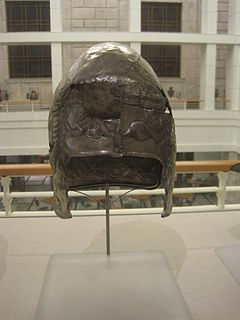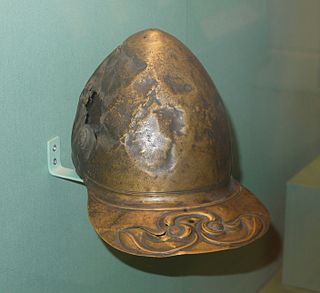 W
WThe Agris Helmet is a ceremonial Celtic helmet from c. 350 BC that was found in a cave near Agris, Charente, France, in 1981. It is a masterpiece of Celtic art, and would probably have been used for display rather than worn in battle. The helmet consists of an iron cap completely covered with bands of bronze. The bronze is in turn covered with unusually pure gold leaf, with embedded coral decorations attached using silver rivets. One of the cheek guards was also found and has similar materials and designs. The helmet is mostly decorated in early Celtic patterns but there are later Celtic motifs and signs of Etruscan or Greek influence. The quality of the gold indicates that the helmet may well have been made locally in the Atlantic region.
 W
WThe Helmet of Agighiol is a Getae silver helmet dating from the 5th century BC, housed in the National Museum of Romanian History, Bucharest.
 W
WThe Golden Helmet of Coțofenești is a Geto-Dacian helmet dating from the first half of the 4th century BC.
 W
WThe Helmet of Iron Gates is a Geto-Dacian silver helmet dating from the 4th century BC, housed in the Detroit Institute of Arts, United States.
 W
WThe Helmet of Peretu is a Geto-Dacian silver helmet dating from the 5th century BC, housed in the National Museum of Romanian History, Bucharest. It comes from Peretu area, in the Teleorman County, Romania. There were 50 artifacts having 750g. The helmet is similar to the Helmet of Coţofeneşti and other three Getian gold or silver helmets discovered so far.
 W
WThe Meyrick Helmet is an Iron Age bronze peaked helmet, with La Tène style decoration, that is held at the British Museum in London. It is one of only four Iron Age helmets to have been discovered in Britain, the other three being the more famous Waterloo Helmet, the Canterbury Helmet and the North Bersted Warrior helmet. Unlike the Waterloo Helmet, which bears two cone-shaped horns, the Meyrick Helmet is hornless and appears to be based on a Roman model. Vincent Megaw, emeritus professor of archaeology at the University of Leicester, has conjectured that the helmet may have belonged to a British auxiliary fighting in the Roman army during the campaigns against the Brigantes in AD 71–74.
 W
WThe Negau helmets are 26 bronze helmets dating to c. 450 BC–350 BC, found in 1812 in a cache in Ženjak, near Negau, Duchy of Styria. The helmets are of typical Etruscan 'vetulonic' shape, sometimes described as of the Negau type. They were buried in c. 50 BC, shortly before the Roman invasion of the area. Helmets of the Negau type were typically worn by priests at the time of deposition of these helmets, so they seem to have been left at the Ženjak site for ceremonial reasons. The village of Ženjak was of great interest to German archaeologists during the Nazi period and was briefly renamed Harigast during World War II. The site has never been excavated properly.
 W
WThe Veksø helmets are a pair of Bronze Age ceremonial horned helmets found near Veksø in Zealand, Denmark.
 W
WThe Waterloo Helmet is a pre-Roman Celtic bronze ceremonial horned helmet with repoussé decoration in the La Tène style, dating to circa 150–50 BC, that was found in 1868 in the River Thames by Waterloo Bridge in London, England. It is now on display at the British Museum in London.